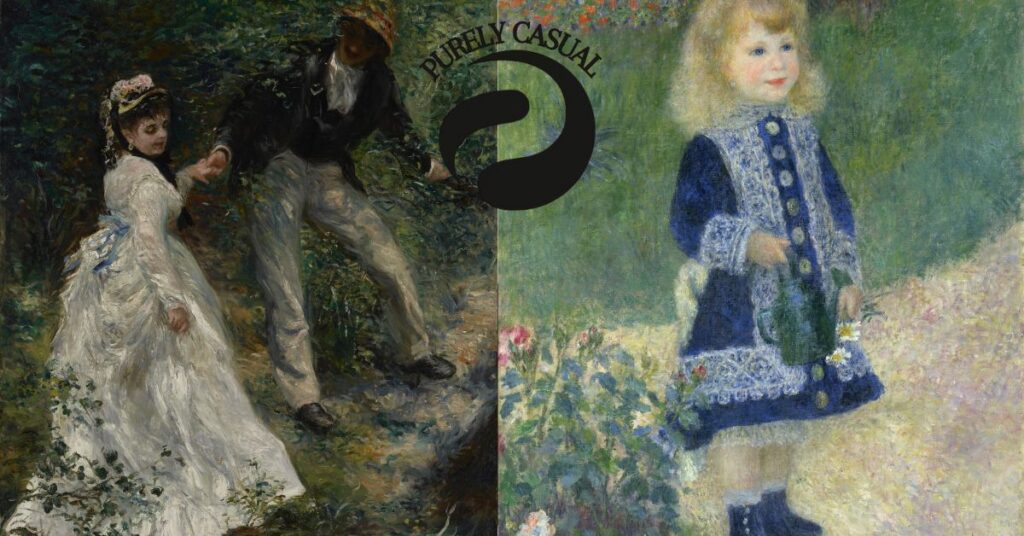Auguste Toulmouche was a notable French painter of the 19th century. He was known for his detailed and refined depictions of bourgeois domestic life. His works, like La Fille, offer a glimpse into the everyday lives of the upper-middle class in France during that time.
La Fille is one of Toulmouche’s most recognized paintings. The title translates to “The Girl” in English. The painting captures a young woman in a moment of quiet reflection. She is elegantly dressed, surrounded by a luxurious interior that reflects the wealth and taste of the bourgeoisie. The attention to detail in the fabrics, furnishings, and her attire highlights Toulmouche’s skill as an academic painter.
Toulmouche was part of the academic art movement, which focused on traditional techniques and subjects. He was trained under the famous painter Charles Gleyre and exhibited regularly at the Paris Salon. His paintings were admired for their technical precision and how they portrayed femininity and domesticity ideals. In La Fille, Toulmouche presents a scene that is both intimate and idealized, offering a window into the expectations placed on women during the 19th century.
This blog post will explore La Fille in depth. We will look at the cultural and social context of the painting. We will analyze its composition, symbolism, and the themes it represents. We will also discuss the reception of the painting both during Toulmouche’s time and in modern art history. Through this exploration, we will gain a deeper understanding of how La Fille reflects the values and aesthetics of its era.
Table Of Contents
Contextual Background
Auguste Toulmouche’s Life and Career
Auguste Toulmouche was a notable French artist born in 1829, renowned for his genre paintings. He studied under the famous Charles Gleyre and gained prominence through his portrayals of bourgeois domestic scenes. His work, including La Fille, highlights his skill in depicting the refined lifestyle of the upper-middle class.
Artistic Style and Influence
Toulmouche’s style is known for its meticulous attention to detail and luxurious interiors. As an academic artist, he emphasized traditional techniques and classical subjects. His paintings, such as La Fille, often feature women in elegantly appointed rooms, reflecting the social norms and aesthetics of 19th-century France.
19th-Century French Society
The 19th century saw significant social changes in France, with the bourgeoisie rising influence. Art from this period frequently showcased their wealth and lifestyle. Toulmouche’s work, including the painting discussed here, provides a glimpse into the domestic lives and values of the bourgeoisie.
The Role of Women in Art
In 19th-century art, women were often depicted in domestic settings, emphasizing their traditional roles. Toulmouche’s paintings, including the one in question, focus on femininity and domesticity. These works highlight the idealized roles of women in bourgeois society.
Detailed Analysis of La Fille
Visual Composition
The painting features a young woman in a luxurious setting. The composition draws the viewer to her graceful pose and the elegant surroundings. Toulmouche’s arrangement of elements creates a harmonious and intimate scene.
Use of Color and Light
Toulmouche uses soft, muted colors to create a serene atmosphere in this work. The careful application of light highlights the fabrics’ textures and the room’s details. This use of color and light enhances the painting’s sense of refinement and elegance.
Symbolism and Themes
The elements in the painting carry symbolic meanings related to social status and domestic ideals. The young woman’s attire and the opulent setting reflect the values of 19th-century bourgeois society. Themes of femininity and purity are central to the portrayal, emphasizing the role of women in this social class.
Comparison with Other Works
The painting shares thematic elements with Toulmouche’s other genre scenes. Each work features similar motifs of domestic elegance and upper-middle-class life. Toulmouche’s focus on detailed, intimate portrayals of domesticity sets his work apart compared to contemporary artists.
Reception and Impact
Contemporary Reception
When first shown, the painting was well-received by critics and the public. It was praised for its detailed depiction of bourgeois life and technical skill. The painting became popular among collectors who valued its portrayal of refined domesticity.
Influence on Other Artists
The artist’s depiction of bourgeois life influenced his peers, setting a standard for detailed and intimate portrayals of the upper-middle class. His focus on domestic interiors and refined subjects impacted other artists exploring similar themes.
Legacy and Long-Term Impact
Over time, the painting has been valued for its historical and artistic significance. It offers insights into 19th-century French society and the role of women. Modern art historians continue to study the painting to understand its cultural context and significance.
Conclusion
Auguste Toulmouche’s La Fille offers a vivid glimpse into 19th-century French bourgeois life, capturing the era’s ideals and domestic elegance. This painting exemplifies Toulmouche’s skill and the artistic trends of his time. Reflecting on the artwork, it’s evident how it conveys the values and beauty of its period, presenting a world of grace and domesticity that still resonates with modern audiences. To deepen your understanding, exploring this painting and others by Toulmouche through museums or online collections is recommended. Further study of 19th-century art can enhance appreciation of how these works mirror societal values and artistic movements. For more insights, art history resources and collections are invaluable in appreciating the broader context of Toulmouche’s contributions.
FAQs
Who was Auguste Toulmouche?
Auguste Toulmouche was a French painter born in 1829, known for his detailed genre paintings that depict bourgeois domestic life. He was trained under Charles Gleyre and gained recognition for his portrayals of upper-middle-class women and their environments.
What is La Fille about?
La Fille, which translates to “The Girl,” is a painting by Toulmouche that features a young woman in an elegant, luxurious interior. The painting captures her in a moment of quiet reflection, highlighting themes of femininity, innocence, and the refined domestic life of the 19th-century bourgeoisie.
What are the key themes in La Fille?
The key themes in La Fille include femininity, innocence, and social status. The painting reflects the idealized role of women in 19th-century bourgeois society and showcases Toulmouche’s focus on domestic elegance and propriety.
How was La Fille received when it was first exhibited?
When La Fille was first exhibited, it was well-received by critics and the public. Toulmouche’s skillful depiction of bourgeois life and attention to detail were praised, and the painting became popular among wealthy collectors.
How does La Fille compare to other works by Toulmouche?
La Fille shares similarities with other works by Toulmouche, particularly in its focus on young women in luxurious domestic settings. However, each painting has unique elements that highlight Toulmouche’s ability to capture the subtleties of bourgeois life.
What impact did Toulmouche have on other artists?
Toulmouche’s depiction of bourgeois life influenced other artists of his time who explored similar themes. His attention to detail and focus on domestic interiors set a standard for depicting the upper-middle class and impacted the portrayal of women in art.
What can modern viewers learn from La Fille?
Modern viewers can gain insights into 19th-century French society, particularly the role and expectations of women in the bourgeois class. The painting also reflects on the cultural values of the time and the ideals of beauty and propriety.
Where can I see La Fille?
La Fille is part of various museum collections and exhibitions featuring 19th-century French art. For those interested in viewing the painting, check museum websites or online collections for its current location and availability.
How can I learn more about Auguste Toulmouche and his work?
To learn more about Auguste Toulmouche and his work, read art history books, visit museum collections, and explore online resources dedicated to 19th-century French art. Art history journals and academic articles also provide in-depth analyses of Toulmouche’s paintings and his impact on the art world.
Why is La Fille considered an essential work of art?
La Fille is considered necessary because it captures the essence of 19th-century bourgeois life and reflects the artistic techniques and themes of the academic art movement. Toulmouche’s detailed portrayal of domestic elegance and his focus on the idealized role of women make this painting a significant piece in art history.







